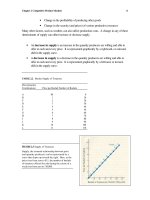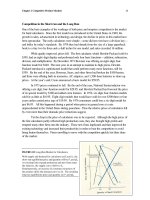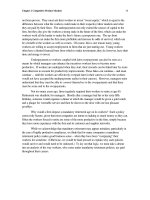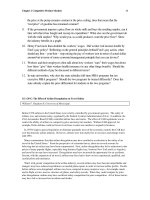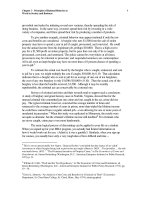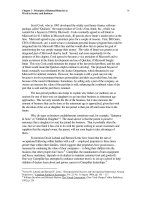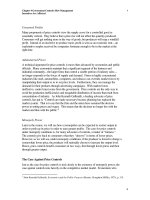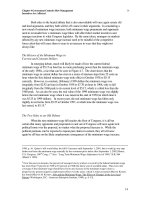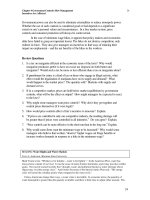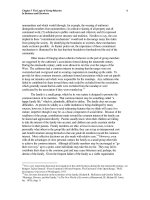Tài liệu Microeconomics for MBAs 25 docx
Bạn đang xem bản rút gọn của tài liệu. Xem và tải ngay bản đầy đủ của tài liệu tại đây (87.02 KB, 10 trang )
Chapter 7 Market Failures: External Costs
And Benefits
10
of meeting the limit of two units is shown in the lower half of Table 7.1. Firm A incurs
the relatively modest cost of $700 ($100 + $200 + $400). But firm B must pay $2,600
($200 + $600 + $1,800). The total cost to all firms is $13,500.
What if the EPA adopts a different strategy and sells rights to pollute? Such
rights can be thought of as tickets that authorize firms to dump a unit of waste into the
atmosphere. The more tickets a firm purchases, the more waste it can dump, and the
more cleanup costs it can avoid.
TABLE 7.1 Costs of Reducing Sulfur Dioxide Emissions
A B C D E
Marginal cost of eliminating
each unit of pollution:
First unit $ 100 $ 200 $ 200 $ 600 $1,000
Second unit 200 600 400 1,000 2,000
Third unit 400 1,800 600 1,400 3,000
Fourth unit 800 5,400 800 1,800 4,000
Fifth unit 1,600 16,200 1,000 2,200 5,000
Cost of Reducing Pollution by Cost of Reducing Pollution by
Establishment of Government Standards Sale of Pollution Rights
Cost to A of eliminating 3 units $ 700 Cost to A of eliminating 4 units $1,500
Cost to B of eliminating 3 units 2,600 Cost to B of eliminating 2 units 800
Cost to C of eliminating 3 units 1,200 Cost to C of eliminating 5 units 3,000
Cost to D of eliminating 3 units 3,000 Cost to D of eliminating 3 units 3,000
Cost to E of eliminating 3 units 6,000 Cost to E of eliminating 1 unit 1,000
Total cost of five units $13,500 Total cost of five units $9,300
Remember that the EPA can control the number of tickets it sells. To limit
pollution to the maximum acceptable level of ten units, all it needs to do is sell no more
than ten tickets. Either way, whether by pollution standards or rights, the level of
pollution is kept down to ten units, but the pollution rights method allows firms that want
to avoid the cost of a cleanup to bid for tickets.
The potential market for such rights can be illustrated by conventional supply and
demand curves, as in Figure 7.5. The supply curve is determined by EPA policymakers,
who limit the number of tickets to ten. Because in this example the supply is fixed, the
supply curve must be vertical (perfectly inelastic). Whatever the price, the number of
pollution rights remains the same. The demand curve is derived from the costs firms
must bear to clean up their emissions. The higher the cost of the cleanup, the more
Chapter 7 Market Failures: External Costs
And Benefits
11
attractive pollution rights will be. As with all demand curves, price and quantity are
inversely related. The lower the price of pollution rights, the higher the quantity
demanded.
Figure 7.5 Market for Pollution Rights
Reducing pollution is costly (see Table 7.1). It adds
to the costs of production, increasing product prices
and reducing the quantities of products demanded.
Therefore firms have a demand for the right to void
pollution abatement costs. The lower the price of
such rights, the greater the quantity of rights that
firms will demand (see Table 18,2). If the
government fixes the supply of rights at ten and sells
those ten rights to the highest bidders, the price of
the rights will settle at the intersection of the supply
and demand curves -- here, $1,500.
Table 7.2 shows the total quantity demanded by the firms at various prices. At a
price of zero, the firms want twenty-five rights (five each). At a price of $201, they
demand only twenty-one. A wants only three, for it will cost less to clean up its first two
units (at costs of $100 and $200) than to buy rights to emit them at a price of $201. B
wants four rights, for its cleanup costs are higher.
Given the information in the table, the market clearing price—the price at which
the quantity of property rights demanded exactly equals the number of rights for sale—
will be something over $1,400—say $1,500. Who will buy those rights, and what will
the cost of the program be?
At a price of $1,500 per ticket, firm A will buy one and only one ticket. At that
price, it is cheaper for the firm to clean up its first four units (the cost of the cleanup is
$100 + $200 + $400 + $800). Only the fifth unit, which would cost $1,600 to clean up,
makes the purchase of a $1,500 ticket worthwhile. Similarly, firm B will buy three
tickets, firm C none, firm D two, and firm E four.
The cost of any cleanup must be measured by the value of the resources that go
into it. The value of the resources is approximated by the firm’s expenditures on the
cleanup—not by their expenditures on pollution tickets. (The tickets do not represent real
resources, but a transfer of purchasing power from the firms to the government.)
Accordingly, the economic cost of reducing pollution to ten units is $9,300; $1,500 for
firm A. $800 for B, $3,000 each for C and D, and $1,000 for E. This figure is
Chapter 7 Market Failures: External Costs
And Benefits
12
significantly less than the $13,500 cost of the cleanup when each firm is required to
eliminate three units of pollution. Yet in each case, fifteen units are eliminated. In shirt,
the pricing system is more economical—more cost-effective or efficient—than setting
standards. Because it is more efficient, it is also the more economical way of producing
goods and services. More resources go into production and less into cleanup.
TABLE 7.2 Demand for Property Rights
Price Quantity Price Quantity
$ 0 25 $1,601 9
101 24 1,801 7
201 21 2,001 6
401 19 2,201 5
601 16 3,001 4
801 14 4,001 3
1,001 11 5,001 2
1,401 10 5,601 0
The idea of selling rights to pollute may not sound attractive, but it makes sense
economically. When the government sets standards, it is giving away rights to pollute.
In our example, telling each firm that it must reduce its sulfur dioxide emissions by three
units is effectively giving them each permission to dump two units into the atmosphere.
One might ask whether the government should be giving away rights to the atmosphere,
which has many other uses besides the absorption of pollution. Though some pollution
may be necessary to continued production, that is no argument for giving away pollution
rights. Land is needed in may production processes, but the Forest Service does not give
away the rights to public lands. When pollution rights are sold, on the other hand,
potential users can express the relative values they place on the right to pollute.
2
In that
way, rights can be assigned to their most valuable and productive uses.
MANAGER’S CORNER: How Honesty Pays in Business
There exist the popular perception that markets fail because business is full of dishonest
scoundrels – especially high ranking executives -- who cheat, lie, steal, and worse to
increase their profits. This perception is reflected in and reinforced by the way business
people are depicted in the media. According to one study, during the 1980s almost 90
percent of all business characters on television were portrayed as corrupt.
3
No one can
2
Note that the system allows environmental group as well as producers to express the value they place on
property rights. If environmental groups think ten units of sulfur dioxide is too much pollution, they can
buy some of the tickets themselves and then not exercise their right to pollute.
3
See page 146 of Robert Lichter, Linda Lichter, and Stanley Rothman, Watching America (New York:
Prentice Hall, 1990).
Chapter 7 Market Failures: External Costs
And Benefits
13
deny that people in business have done all kinds of nasty things for a buck. But the
impression of pervasive dishonest business people is greatly exaggerated. Business
people are no more likely to behave dishonestly than other people. In fact, there are
reasons to believe that business people might be more honest than the typical American
on the street. Moreover, there are ways business people can commit themselves to
incentive arrangements that motivate honest behavior in ways that their customers find
convincing.
The Role of Honesty in Business
The case to be made for honesty in business is not based on any claim that business
people are particularly virtuous, or ethical to the core of their beings. We can make no
claim to keen insights into the virtue of business people or anyone else. We might even
be persuaded that business people have less virtue on average than do those who choose
more caring occupations, such as teachers, social workers, missionaries, and nurses. But
we do claim to know one simple fact about human behavior, and that is people respond to
incentives in fairly predictable ways. In particular, the lower the personal cost of
dishonesty, the greater the extent of dishonestly within most identified groups of people.
If business people act honestly to an unusual degree (or different from what other people
in other situations do), it must be in part because they expect to pay a high price for be-
having dishonestly. This is, in fact, the case because business people have found, some-
what paradoxically, that they can increase profits by accepting institutional and
contractual arrangements that impose large losses on them if they are dishonest.
Though seldom mentioned, most business activity requires a high degree of
honest behavior. If business is going to be conducted at any but the simplest level,
products must be represented honestly, promises must be kept, costly commitments must
be made, and business people must cooperate with each other to take the interests of
others, particularly consumers, into consideration. Indeed, if the proverbial man from
Mars came down and observed business activity, he might very well conclude that
business people are extraordinarily honest, trusting, and cooperative. They sell precious
gems that really are precious to customers who cannot tell the difference between a dia-
mond and cut glass. They promise not to raise the price of a product once customers
make investments that make switching to another product costly, and they typically keep
the promise. They make good faith pledges that the businesses they own, but are about to
sell, will continue to give their customers good service. They commit themselves to
costly investments to serve customers knowing the investments will become worthless if
customers shift their business elsewhere.
The way business people behave in the marketplace suggests a level of morality
that is at variance with the self-interest that economists assume, in their theoretical
models, motivates business activity. Some argue that the economist’s assumption of self
interest is extreme, and we recognize that many people, including many business people,
behave honestly simply because they feel it is the right thing to do. But few would
recommend that we blindly trust in the honesty of others when engaged in business
activity. The person who is foolish enough to assume that all business people are honest
Chapter 7 Market Failures: External Costs
And Benefits
14
and trustworthy only has to encounter a few who are not to find himself separated quickly
from his wealth.
Is there a contradiction here between the honesty that characterizes most business
activity and the fact that business people are not generally assumed to be honest? The
answer is no. Indeed, the reason business people generally behave honestly is best
explained by the fact that it would be foolish to assume that they are honest. And many
business people are honest precisely because others assume they won’t be.
It is easy to imagine a situation in which business people can profit at the expense
of their customers, workers, and others with whom they deal if they behave deceitfully.
For example, the quality of many products (say used cars or diamonds) is difficult for
consumers to easily determine. The seller who takes advantage of this by charging a high
quality price for a low quality product would capture extra profits from the sale. A
business owner who is about to retire can profit by making promises not to be fulfilled
until after his retirement, and which he does not plan to keep. The monopoly producer of
a superior product (but one which requires the consumer to make costly investments in
order to use it) can offer the product at a low price and then, once the consumer becomes
dependent on it, increase the price significantly. Other examples of the potential profit
from dishonest behavior are easily imagined. In fact, such examples are about the only
type of behavior some people ever associate with business.
Again, we want to emphasize that dishonest behavior of the above type does
occur. But such dishonest behavior is the exception, not the rule of much business,
despite the story-telling talents of Hollywood writers. The reason is that in addition to
being a virtue from a strictly moral perspective, honesty is also important for quite
materialistic reasons. An economy in which people deal with each other honestly can
produce more wealth than one in which people are chronically dishonest. So there are
gains to be realized from honesty, and when there are gains to be captured there are
people who, given the opportunities available in market economies, will devise ways to
capture them.
A businessperson who attempts to profit from dishonest dealing faces the fact that
few people are naively trusting. It may be possible to profit from dishonesty in the short
run, but those who do so find it increasingly difficult to get people to deal with them in
the long run. And in some businesses it is extremely difficult to profit from dishonesty
even in the short run. How many people, for example, would pay full price for a
“genuine” Rolex watch, or diamond necklace, from someone selling them out of a Volks-
wagen van at the curb of a busy street? Without being able to provide some assurance of
honesty, the opportunities to profit in business are very limited.
So business people have a strong motivation to put themselves in situations in
which dishonest behavior is penalized. Only by doing so can they provide potential
customers, workers, and investors with the assurance of honest dealing required if they
are to become actual customers, workers, and investors.
The advantage of honesty in business can be illustrated by considering the
problem facing Mary who has a well-maintained 1990 Honda Accord that she is willing
to sell for as little as $4,000. If interested buyers know how well maintained the car is,
